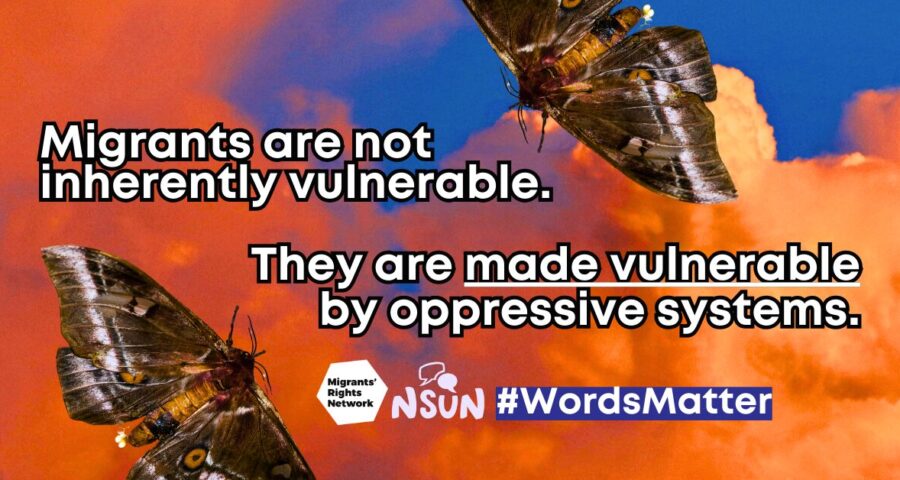This piece was written by The Migrants’ Rights Network in collaboration with NSUN as a contribution to MRN’s Words Matter campaign, which aims to explore the ramifications of certain language, and to show solidarity to migratised communities by standing up against harmful narratives.
The language of vulnerability is often used in conjunction with migrants and other marginalised groups. While many migrants are made vulnerable by the structures they interact with (e.g. immigration systems) or as a result of traumatic experiences which can result in ill health or disability, they are often generalised as being an inherently vulnerable group. Migrants, including refugees, are given the blanket label of ‘vulnerable’. While it’s sometimes important to ‘prove’ vulnerability, so that migrants who have been made vulnerable can access support services, such as mental health services or gender-affirming care for trans+ migrants, the term ‘vulnerability’ has become something of a buzzword. This word is applied very individualistically, rather than interrogating the harmful systems or conditions that create vulnerability.
‘Vulnerability’ manifests in very different ways depending on the group or person in question, and we must apply an intersectional approach when exploring how vulnerability is created. Under oppressive systems, gender, sexuality, disability, race, ethnicity, religion or age can all intersect, which defines how vulnerability is constructed , and who has access to the support they need. As part of our Words Matter campaign, we’re exploring the concept of ‘vulnerability’, in relation to disability and migration, with our friends at the National Survivor User Network (NSUN).
Should we think of and describe people on the move as ‘vulnerable’?
While the concept of vulnerability is commonly referred to in conversations around migration, it is often incredibly malleable and poorly defined. Vulnerability most often presents itself as a vague state of passive, apolitical victimhood imposed by Western organisations and governments onto racialised groups. Even a 2018 report from the Independent Chief Inspector for Borders and Immigration into the Home Office’s approach to safeguarding ‘vulnerable’ adults highlighted how using the word risks ‘locat[ing] the cause of abuse with the victim’.
The idea of the inherently vulnerable individual also enables the ‘White Saviour’ complex. The predominantly White-led charity and aid sector can dictate who is constructed as ‘vulnerable’ and therefore what is needed to support that person. This reinforces the problematic power dynamic in support services and charities because it takes away the agency or decision-making abilities for marginalised groups to dictate what resources they want or need.
There are no inherently ‘vulnerable’ migrants, only those who are made vulnerable and kept in precarious situations by oppressive systems.
We reject the labelling of people on the move as ‘vulnerable’ as this implies an inherent lack of agency and control over their own lives. Describing people as such obscures the structures that keep migratised communities precarious, such as the lack of safe routes to seek asylum in the UK, prohibitively expensive visa application processes and the encroachment of border enforcement into our schools, hospitals and workplaces.
People seeking sanctuary from across the Global South may also be constructed as ‘vulnerable’ because of political or economic instability in their home countries. Once again, this obscures that vast areas of the world have been destabilised by centuries of colonialism and military intervention by the Global North. These processes are not apolitical, but the direct results of policy decisions made by Western governments past and present.
What else does ‘vulnerability’ imply?
The passiveness that ‘vulnerability’ tends to denote when it is applied to migrants lends it a distinctly gendered quality. Often, meek, ‘vulnerable’ women and girls on the move are constructed in opposition to hostile, ‘fighting age’ men in similar situations. Both of these categories are reductive and harmful; one denying people’s agency and the other playing on discriminatory tropes to justify inhumane migration policies.
There have been efforts within some humanitarian organisations to expand understandings of ‘vulnerability’ to acknowledge specific challenges faced by men seeking safety. While beginning to deconstruct ‘vulnerability’ is a step in the right direction, this does not go far enough.
Who decides who is ‘vulnerable’?
Even when it is made more inclusive, the concept of ‘vulnerability’ remains an artificial one that is imposed on racialised migrants from the Global South. Instead of allowing people on the move to define their own needs, it only serves to justify more oppressive Western humanitarianism. This means that people from the Global North continue to make decisions about migrants’ lives.
We also know that members of migratised communities that are dependent on humanitarian aid are well aware of Western conceptions of ‘vulnerability’. This can lead people in these situations to ‘perform powerlessness’ at the expense of expressing their actual opinions and needs.
Vulnerability is complex, and looks different for everyone. Passively applying the term ‘vulnerable’ to entire groups can both dismiss and infantilise them. Instead, we should look at the systemic issues that create and exacerbate vulnerability so that we can collectively tackle the root causes that expose people to risk or harm.
We are exploring the relationship between migration status, immigration systems and disability through our Who is Welcome: Disability and Migration campaign.

